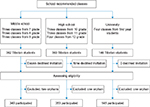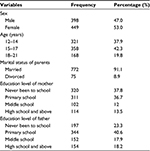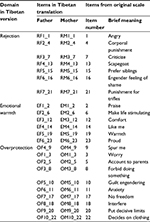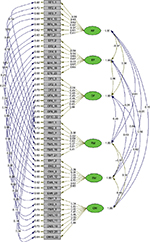Back to Journals » Psychology Research and Behavior Management » Volume 10
Validity and reliability of the Tibetan version of s-EMBU for measuring parenting styles
Authors Yangzong C, Lerkiatbundit S, Luobu O, Cui C, Liabsuetrakul T , Kangzhuo B, Quzong D, Zhandui L, Zhen P, Chongsuvivatwong V
Received 21 April 2016
Accepted for publication 30 May 2016
Published 20 December 2016 Volume 2017:10 Pages 1—8
DOI https://doi.org/10.2147/PRBM.S111073
Checked for plagiarism Yes
Review by Single anonymous peer review
Peer reviewer comments 2
Editor who approved publication: Dr Igor Elman
Ciren Yangzong,1,2 Sanguan Lerkiatbundit,3 Ouzhu Luobu,4 Chaoying Cui,4 Tippawan Liabsuetrakul,2 Baima Kangzhuo,4 Deji Quzong,4 Luobu Zhandui,5 Pu Zhen,6 Virasakdi Chongsuvivatwong2
1Department of Preventive Medicine, Medical College, Tibet University, Lhasa, Tibet Autonomous Region, People’s Republic of China; 2Epidemiology Unit, Faculty of Medicine, 3Department of Pharmacy Administration, Faculty of Pharmaceutical Science, Prince of Songkla University, Songkhla, Thailand; 4High Altitude Research Centre, 5Experimental Centre, 6Department of Pharmaceutical Science, Medical College, Tibet University, Lhasa, Tibet Autonomous Region, People’s Republic of China
Abstract: Parenting style experienced during childhood has profound effects on children’s futures. Scales developed in other countries have never been validated in the Tibetan context. The present study aimed to examine the construct validity and reliability of a Tibetan translation of the 23-item short form of the Egna Minnen Beträffande Uppfostran [One’s Memories of Upbringing] (s-EMBU) and to test the correlation between the parenting styles of fathers and mothers. A cross-sectional study was conducted in a sample of 847 students aged 12–21 years from Lhasa, Tibet, during September and October 2015 with a participation rate of 97.7%. The Tibetan translation of self-completed s-EMBU was administered. Confirmatory factor analysis was employed to test the scale’s validity on the first half of the sample and was then cross-validated with the second half of the sample. The final model consisted of six factors: three (rejection, emotional warmth, and overprotection) for each parent, equality constrained on factor loadings, factor correlations, and error variance between father and mother. Father–mother correlation coefficients ranged from 0.81 to 0.86, and the level of consistency ranged from 0.62 to 0.82. Thus, the slightly modified s-EMBU is suitable for use in the Tibetan culture where both the father and the mother have consistent parenting styles.
Keywords: Tibetan, parenting style, s-EMBU, validity, reliability, Egna Minnen Beträffande Uppfostran
Background
Parenting style reflects parents’ attitudes toward their children which are then communicated to them, and the emotional climate in which these attitudes are expressed. Negative parenting style is one cause of early maladaptive schemas which can increase the risk of emotional problems such as anxiety and depression.1–5 Parenting style also has profound effects on cognitive outcomes reflected by academic achievement.6–9 Over the past 50 years, there have been a number of theories about the dimensions of parenting style. For example, Barber described a dimension of parental psychological control.10
Parenting style is known to be culturally dependent. Loter found distinct parenting styles of mothers among three ethnic groups in Germany.11 German mothers had a more permissive style, Vietnamese mothers displayed a more authoritarian style, whereas the prevailing parenting style for Turkish mothers was neglectful. In another study conducted in the US and the People’s Republic of China, Chinese parents tended to be more controlling than their Western counterparts.12
In the People’s Republic of China, Tibetans are an ethnic minority group with a distinct culture, and most live in a relatively remote area with little social competition. Parents are relatively calm and communicative and rarely hit their children.13 Although there have been a few studies looking at parenting styles of Tibetans, the scales were in Chinese or without validation.14,15 The use of these scales cannot overcome the cultural barriers.
The Egna Minnen Beträffande Uppfostran [One’s Memories of Upbringing] (EMBU) developed by Perris et al16 in 1980 is among the most frequently used parenting style assessment scales.17 Originally, EMBU had 81 items,18 but the more commonly used short form (s-EMBU) has 23 items,17,19–21 which has been proven to be practical in adults, adolescents, and psychiatric patients.17,21,22
Agreement in parenting styles of the father and mother was shown to contribute to the social competence of children.23–27 Thus, correlation between the parenting styles of the father and mother was also tested in our study.
Our study objectives were to examine the construct validity and reliability of a Tibetan translation of the s-EMBU and to test the correlation between the parenting styles of father and mother.
Methods
Study design and setting
This cross-sectional study was conducted in Lhasa, the capital city of Tibet Autonomous Region of China, during September and October 2015. In the 2010 National census, the population of Lhasa was ~559,000, of which 76% were Tibetans. To increase the variation of age, the subjects were recruited from one middle school, one high school, and one university, all of which were public schools.
Sample size and sampling
To yield a stable factor solution in factor analysis, a sample of at least 300 is generally required.28 To validate and cross-validate the s-EMBU using confirmatory factor analysis (CFA) on two split halves of the data set, a sample size of at least 600 was required. Assuming a nonresponse rate of 25%, the sample size was increased to 800.
The detailed subject recruitment procedure is summarized in Figure 1. Classes were chosen by the schools based on their readiness to participate. Inclusion criterion for the students was being Tibetan adolescents. Orphans and those with mental problems were excluded from the study. Of 871 students invited, 20 refused (response rate =97.7%) to participate in the study. Unwillingness in releasing certain personal information was the main reason for nonparticipation. After excluding four orphans, 847 Tibetan adolescents voluntarily participated in the study and no payment was given for participation.
  | Figure 1 Consort diagram of the subject recruitment. |
Instruments
The original s-EMBU scale20,21 has been used to assess three dimensions of parenting style, including rejection (seven items), emotional warmth (six items), and overprotection (ten items). Rejection is characterized by a critical and judgmental approach to parenting. Emotional warmth is shown through parenting attitudes of acceptance, support, and value; whereas, overprotection is characterized by being fearful for a child’s safety and having a high degree of control over them.
The scale includes father and mother forms with 23 items in each form. The items are scored on a four-point Likert scale (1: never; 2: yes, but seldom; 3: yes, often; 4: yes, always). The items of the original s-EMBU scale were randomly mixed and for the purposes of this study, the items were named as RF1_1-RF7_21, EF1_2-EF6_23, and OF1_3-OF10_22 for the father’s domain of rejection, emotional warmth, and overprotection, respectively. The mother’s domain of rejection, emotional warmth, and overprotection were renamed as RM1_1-RM7_21, EM1_2-EM6_23, and OM1_3-OM10 _22, respectively. The corresponding meaning of all items in the original questionnaire is described in Table 1.
Procedures
The present study was approved by the Ethics Committee of the Faculty of Medicine, Prince of Songkla University, Hat Yai, Songkhla Province, Thailand (reference number: 57-187-18-5) before the research was conducted.
The English version of the s-EMBU was translated into the Tibetan language by one expert and back translated by another expert. After comparison, dissimilarities between the original English version and the back-translated English version were resolved by a third expert. All these three experts were Tibetans residing in Tibet Autonomous Region and had studied in an English speaking county for more than 5 years. The scale was further pretested on ten students from Tibet University whose opinions were incorporated into the final version.
For the students aged under 18 years, permission to be enrolled in the study was obtained from the student’s parents and school authorities. Otherwise, the permission was obtained by written informed consent from participants. The participants completed the s-EMBU (Tibetan version) and the questionnaire containing items on sociodemographic characteristics in their classrooms with necessary facilitation by a research assistant.
Analysis
The data set was randomly split into two groups of almost equal size (424:423). Since a three-factor structure of s-EMBU had already been established from a number of countries and cultures, CFA was employed to test the validity of the three-factor structure for each parent in the first data set and refined to obtain the most appropriate model. This model was then tested for fitness with the second half of the data set. In CFA, a maximum likelihood estimation method was used and the covariance matrix was analyzed to assess the fit of the model. LISREL version 8.8 was used to do the factor analysis and R version 3.2.2 was used for all other statistical analyses.
The following measures and cut points were employed to assess the fit of the CFA models: root mean square error of approximation (RMSEA) <0.05 (good fit), <0.06 (acceptable);29,30 standardized root mean square residual (SRMR) <0.08 (good fit);29,30 comparative fit index (CFI) ≥0.90 (acceptable), ≥0.95 (good fit);29,30 and Tucker–Lewis index ≥0.90 (acceptable), ≥0.95 (good fit).29,30 In terms of factor loadings, the generally accepted cut point of 0.3, indicating medium loading, was used to include the items from the CFA.29 A Cronbach’s alpha coefficient, which is used to determine the internal consistencies of subscales, higher than 0.6 is considered acceptable.31
A two-factor model with one factor for each parent, which indicates that all items in each of the parent’s forms represent only one domain, was fitted first. The main model was a six-factor model with three factors representing three parts for the father’s parenting style and another three factors for the mother’s parenting style. Previous studies reported findings on cross-loadings of item OF4_9/OM4_9 on emotional warmth and overprotection.19,21 These cross-loadings were also specified in the tested models. Since the items in the father and mother forms were identical and answered by the same participants, the covariance between residuals of the same item in father and mother forms was specified in all computations.
The initial main model was computed with different loadings for the father and mother. It was then simplified with constraints allowing parents to have the same loadings, same correlation coefficient between factors, and same variance in the error. To compare the nested models with and without equality constraints of factors loadings, factor correlations, and error variance in father and mother, the change in CFI (ΔCFI) <0.01 was used to identify the most efficient model.29
Results
Demographic characteristics
The detailed characteristics of the students, their parents, and their families are presented in Table 2. The age of students ranged from 12.2 to 20.8 years (median =15.9, interquartile range =14.3–17.8), and females predominated the sample (53.0%). Regarding the education level of parents, around three-quarters of the mothers and two-thirds of the fathers had never been to school, or had attended primary school only.
  | Table 2 Sociodemographic characteristics of students and their parents |
Construct validity of the s-EMBU
There were no significant differences between the two split data sets with respect to the children’s age and sex and the marital status and education level of parents.
Table 3 summarizes the results of model selection. The null model with two factors (Model 1, one factor for each parent) was not valid by any criteria. Model 2 followed the methodology proposed by Arrindell et al,21that is, containing three factors for each parent, with a cross-loading of OF4_9/OM4_9 on emotional warmth and overprotection. This model fit the data well except that loadings for OF7_17/OM7_17 and OF4_9/OM4_9 on overprotection were low (<0.2). Model 3 was an improvement over Model 2, where the low loading items and path of OF4_9/OM4_9 on overprotection were removed. This improvement was evidenced by a slight increase in CFI and TLI. The good fit of Model 3 meant that the number of factors in the father and mother forms were the same. Model 4 was a further improvement over Model 3, where constraints on the factor loadings for the father and mother were equal, and the fit was acceptable. The fit of Model 4 was similar to Model 3 (ΔCFI =0.006). The equality of factor loadings in the father and mother forms denoted that the children perceived the parenting styles of their fathers and mothers in the same way. Model 5 was a further refinement of Model 4, where equal factor correlations were allowed between the mother and father with a minor reduction in CFI. In Model 6, for the aforementioned reason, the error variance of items was constrained to be equal and the model was still acceptable with ΔCFI =0.001. The equal error variance between father and mother indicates that the reliability of the two forms is similar. Although Model 6 included the fewest number of parameters, it showed only a small change in CFI, and thus was chosen as the final model. Fitting the model to the second half of the data set gave an acceptable fit – RMSEA (90% confidence interval) of 0.44 (0.041–0.048), SRMR of 0.074, Tucker–Lewis index of 0.940, and CFI of 0.942.
A path diagram of Model 6 with equality constraints on factor loadings, factor correlation, and error variance is shown in Figure 2. All factor loadings were acceptable (being above 0.30).29 A high factor loading of an item on a given construct indicates convergent validity of that item, implying it is a good measure for the construct. Four of seven items on rejection and five of seven items on emotional warmth had factor loadings greater than 0.5. However, factor loadings on all eight items of overprotection were between 0.34 and 0.50. Therefore, items on rejection and emotional warmth showed stronger evidence on convergent validity compared to those on overprotection.
The correlations among three types of parenting styles in father and mother ranged from -0.37 to 0.56 (Figure 2), implying that each style was distinct. Rejection was negatively correlated with emotional warmth, while overprotection was positively correlated with both rejection and emotional warmth.
Reliability of the s-EMBU scale
The Cronbach’s alpha coefficients for each subscale of parenting style are presented in Table 4. The Cronbach’s alpha coefficients ranged from 0.62 to 0.82.
Discussion
Our sample included Tibetan adolescents with a slightly higher proportion of females. A model with six factors, three for each parent, that is, equality constrained on factor loadings, factor correlations, and error variance between the father and mother forms, was found to be the most efficient one. The level of consistency was acceptable. Except for one item which needed to be removed and another item that needed to be transferred across to another domain, CFA suggested that the three factors underlying the scales are valid. The parenting styles of Tibetan fathers and mothers were highly correlated.
In this study, Tibetan children perceived the parenting styles of their fathers and mothers in the same way. The high correlation between the same factors in the father and mother models also indicated that their parenting styles were similar. The correlation in parenting style of the father and mother found in this population may reflect that marital conflict was not common. The consistent parenting style prevents confusion in the children, and thus is beneficial to them.32
Since rearing behavior is culturally dependent on activities,11 some items which were a good measure in the Western culture might not be suitable in a Tibetan context. The CFA in this study revealed that items OF7_17 and OM7_17 (I was allowed to go where I liked without my parents caring too much) had low loadings. This may indicate that this item is not suitable for the Tibetan children. However, the culturally specific reason for this is not clear. Furthermore, items OF4_9 and OM4_9 (My parents tried to spur me to become the best), originally designed to measure overprotection, was found to be a measure of emotional warmth in this study. This finding is consistent with those from studies in Australia, Venezuela, and Guatemala.19,21 Our finding in Tibetan children is understandable since parental control, especially on learning in school, may be perceived as an expression of care or concern and being acceptable by Asian children.33 Thus, transfer of this item from the overprotection subscale to the emotional warmth subscale needs to be considered.
The reliability of all subscales in this study was acceptable. However, since the reliability of overprotection in the father form was rather low, further studies are needed to confirm this.
Strengths and limitations
The sample size of current study was big enough to yield a stable solution in CFA and confirm it. The homogenous culture of the study sample ensured the homogeneity of the study sample.
Since nonrandom sampling was employed, generalization of the results is limited. Convergent and discriminant validity was not tested thoroughly in relation to other scales.
Conclusion and implications
The revised Tibetan version of the s-EMBU could be used in the future for both research and clinical patients.
Acknowledgments
We thank Mr Edward McNeil for helping edit the final manuscript. This study is part of the first author’s thesis to fulfill the requirements for a PhD degree in Epidemiology at Prince of Songkla University.
Disclosure
The authors report no conflicts of interest in this work.
References
Mousavi S, Low W, Hashim A. The relationships between perceived parental rearing style and anxiety symptoms in Malaysian adolescents: the mediating role of early maladaptive schemas. J Depress Anxiety. 2016;2:2167–1044. | ||
Koerner N, Tallon K, Kusec A. Maladaptive core beliefs and their relation to generalized anxiety disorder. Cogn Behav Ther. 2015;44(6):441–455. | ||
Shorey RC, Elmquist J, Anderson S, Stuart GL. The relationship between early maladaptive schemas, depression, and generalized anxiety among adults seeking residential treatment for substance use disorders. J Psychoactive Drugs. 2015;47(3):230–238. | ||
Young BJ, Wallace DP, Imig M, Borgerding L, Brown-Jacobsen AM, Whiteside SP. Parenting behaviors and childhood anxiety: a psychometric investigation of the EMBU-C. J Child Fam Stud. 2013;22(8):1138–1146. | ||
Chorpita BF, Barlow DH. The development of anxiety: the role of control in the early environment. Psychol Bull.1998;124(1):3–21. | ||
Ishak Z, Low SF, Lau PL. Parenting style as a moderator for students’ academic achievement. J Sci Educ Technol. 2012;21(4):487–493. | ||
Huey EL, Sayler MF, Rinn AN. Effects of family functioning and parenting style on early entrants’ academic performance and program completion. J Educ Gift. 2013:36(4):418. | ||
Karbach J, Gottschling J, Spengler M, Hegewald K, Spinath FM. Parental involvement and general cognitive ability as predictors of domain-specific academic achievement in early adolescence. Learn Instr. 2013;23:43–51. | ||
Jabagchourian JJ, Sorkhabi N, Quach W, Strage A. Parenting styles and practices of Latino parents and Latino fifth graders’ academic, cognitive, social, and behavioral outcomes. Hisp J Behav Sci. 2014;36(2):175–194. | ||
Barber BK. Parental psychological control: revisiting a neglected construct. Child Dev. 1996;67(6):3296–3319. | ||
Lotter V. Parenting styles and perceived instrumentality of schooling in native, Turkish, and Vietnamese families in Germany. Z Erziehwiss. 2015:18(4):845–869. | ||
Qin L, Pomerantz EM, Wang Q. Are gains in decision-making autonomy during early adolescence beneficial for emotional functioning? The case of the United States and China. Child Dev. 2009;80(6):1705–1721. | ||
Liu M, Long Q. Investigation on parenting style status of college freshman of Tibet Autonomous Region. China J Health Psychol. 2010;18(11):1362–1364. | ||
Yang PzFJHLJ. Relationship between parenting style and self-congruence in Tibetan middle school students. Chin Mental Health J. 2015;29(4):284–289. | ||
Yang PZHLJ. The relationship between parenting style and learning engagement of Tibet junior middle school students. China J Health Psychol. 2015;23(7):1071–1074. | ||
Perris C, Jacobsson L, Linndström H, Knorring Lv, Perris H. Development of a new inventory for assessing memories of parental rearing behaviour. Acta Psychiatr Scand. 1980;61(4):265–274. | ||
Li Z, Wang L, Zhang L. Exploratory and confirmatory factor analysis of a short-form of the EMBU among Chinese adolescents. Psychol Rep. 2012;110(1):263–275. | ||
Aluja A, Del Barrio V, Garcia LF. Comparison of several shortened versions of the EMBU: exploratory and confirmatory factor analyses. Scand J Psychol. 2006;47(1):23–31. | ||
Arrindell W, Akkerman A, Bagés N, Zaldivar F. The short-EMBU in Australia, Spain, and Venezuela. Eur J Psychol Assess. 2005;21(1):56–66. | ||
Arrindell WA, Richter J, Eisemann M, et al. The short-EMBU in East-Germany and Sweden: a cross-national factorial validity extension. Scand J Psychol. 2001;42(2):157–160. | ||
Arrindell WA, Sanavio E, Aguilar G, et al. The development of a short form of the EMBU: its appraisal with students in Greece, Guatemala, Hungary and Italy. Pers Individ Dif. 1999;27(4):613–628. | ||
Jones C, Harris G, Leung N. Parental rearing behaviours and eating disorders: the moderating role of core beliefs. Eat Behav. 2005;6(4):355–364. | ||
Ryan RM, Martin A, Brooks-Gunn J. Is one good parent good enough? Patterns of mother and father parenting and child cognitive outcomes at 24 and 36 months. Parent Sci Pract 2006;6(2–3):211–228. | ||
Simons LG, Conger RD. Linking mother–father differences in parenting to a typology of family parenting styles and adolescent outcomes. J Fam Issues. 2007;28(2):212–241. | ||
Lindsey EW, Mize J. Interparental agreement, parent–child responsiveness, and children’s peer competence. Fam Relat. 2001;50(4):348–354. | ||
Gamble WC, Ramakumar S, Diaz A. Maternal and paternal similarities and differences in parenting: an examination of Mexican-American parents of young children. Early Child Res Q. 2007;22(1):72–88. | ||
Winsler A, Madigan AL, Aquilino SA. Correspondence between maternal and paternal parenting styles in early childhood. Early Child Res Q. 2005;20(1):1–12. | ||
Field A, Miles J, Field Z. Discovering Statistics Using R. London: Sage; 2012:769–770. | ||
Brown TA. Confirmatory Factor Analysis for Applied Research. 2nd ed. New York: Guilford Publications; 2015:27–284. | ||
Hu Lt, Bentler PM. Cutoff criteria for fit indexes in covariance structure analysis: conventional criteria versus new alternatives. Struct Equ Modeling. 1999;6(1):1–55. | ||
Aron A, Coups EJ, Aron EN. Statistics for Psychology. Vol 6. New York, NY: Pearson Education, Inc; 2012:625–627. | ||
Tavassolie T, Dudding S, Madigan A, Thorvardarson E, Winsler A. Differences in perceived parenting style between mothers and fathers: implications for child outcomes and marital conflict. J Child Fam Stud. 2016:25(6):2055–2068. | ||
Pomerantz EM, Wang Q. The role of parental control in children’s development in Western and East Asian countries. Curr Dir Psychol 2009;18(5):285–289. |
 © 2016 The Author(s). This work is published and licensed by Dove Medical Press Limited. The full terms of this license are available at https://www.dovepress.com/terms.php and incorporate the Creative Commons Attribution - Non Commercial (unported, v3.0) License.
By accessing the work you hereby accept the Terms. Non-commercial uses of the work are permitted without any further permission from Dove Medical Press Limited, provided the work is properly attributed. For permission for commercial use of this work, please see paragraphs 4.2 and 5 of our Terms.
© 2016 The Author(s). This work is published and licensed by Dove Medical Press Limited. The full terms of this license are available at https://www.dovepress.com/terms.php and incorporate the Creative Commons Attribution - Non Commercial (unported, v3.0) License.
By accessing the work you hereby accept the Terms. Non-commercial uses of the work are permitted without any further permission from Dove Medical Press Limited, provided the work is properly attributed. For permission for commercial use of this work, please see paragraphs 4.2 and 5 of our Terms.




